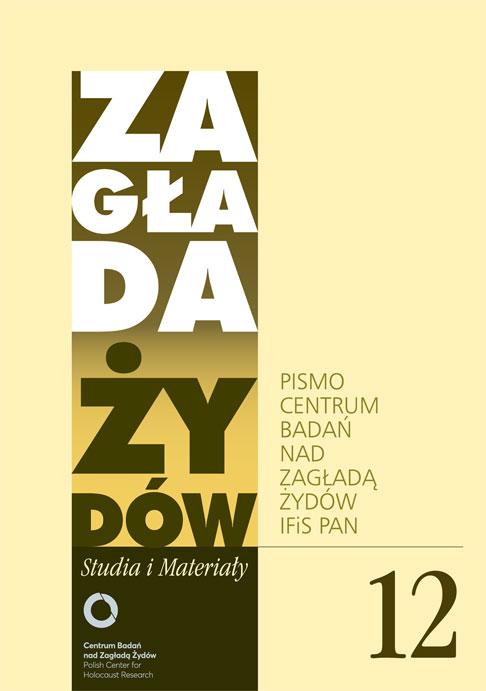Frankenstein w warszawskim getcie. Historia i legenda
Zagłada Żydów. Studia i Materiały, Nr 12 (2016), Strony: 187-208
Data zgłoszenia: 2020-10-19Data publikacji: 2016-11-30
 https://doi.org/10.32927/ZZSiM.414
https://doi.org/10.32927/ZZSiM.414
Abstrakt
The article deals with one exceptionally violent German perpetrator who was part of the occupation force in Warsaw during the Second World War. Inside the Ghetto he maltreated and killed a large number of women, children and men for his own personal pleasure. He did this to such an extensive degree that the population perceived him as monstrous being that was given the nickname „Frankenstein”. The article is mainly based on statements in juridical investigations, from the victim as well as from the perpetrator perspective, supplemented with some selected additional sources. Firstly the source corpus will be evaluated, to work out how these historical sources can be used to shed light on „Frankenstein”. This will be followed by an analysis of the actual identity of this perpetrator. It will be shown that he was, contrary to common belief, not necessarily the SS-Rottenführer Josef Blösche but more likely a member of the German Police Battalion 61. In the end the question will be also raised of how it was possible – despite all rules and regulations – that ghetto guards like him behaved like a marauding soldiery.
Słowa kluczowe
getto warszawskie , Zagłada , policja umundurowana , zbrodnie okupacyjne , warty w getcie , batalion policyjny , sprawca , przemoc , strach , terror , życie w getcie
Licencja
Prawa autorskie (c) 2016 Autor&"Zagłada Żydów. Studia i Materiały"

Utwór dostępny jest na licencji Creative Commons Uznanie autorstwa 4.0 Międzynarodowe.
https://creativecommons.org/licenses/by/4.0
Czasopismo publikowane jest w standardzie Diamond Open Access na licencji CC-BY-4.0 Deed - Uznanie autorstwa 4.0 Międzynarodowa - Creative Commons
Podobne artykuły
- Adam Szostkiewicz, David Cesarini, Eichmann: jego życie i zbrodnie , Zagłada Żydów. Studia i Materiały: Nr 5 (2009)
- Jacek Leociak, The Image of Poles in the Writings of Jews from the Warsaw District , Zagłada Żydów. Studia i Materiały: Nr Holocaust Studies and Materials (2013)
- Agnieszka Witkowska, Ostatnia droga mieszkańców i pracowników warszawskiego Domu Sierot , Zagłada Żydów. Studia i Materiały: Nr 6 (2010)
- Ewa Wiatr, Knights of the Iron Cross in the Łódź Ghetto , Zagłada Żydów. Studia i Materiały: Nr Holocaust Studies and Materials (2013)
- Zofia Wóycicka, U „kresu pewnej moralności”: dyskusje wokół procesów więźniów funkcyjnych w Polsce 1945–1950 , Zagłada Żydów. Studia i Materiały: Nr 3 (2007)
- Marta Pietrzykowska, Jacek Leociak, Spojrzenia na warszawskie getto, Warszawa: Dom Spotkań z Historią, 2011, 268 s. , Zagłada Żydów. Studia i Materiały: Nr 7 (2011)
- Marta Janczewska, Jan Jagielski 1937-2021 , Zagłada Żydów. Studia i Materiały: Nr 17 (2021)
- Piotr Litka, Zdzisław Lorek, Grzegorz Pawlikowski, Nieznane opracowanie: Waldemar Szulc, „Chełmno nad Nerem (Kulmhof). Hitlerowski obóz natychmiastowej zagłady” , Zagłada Żydów. Studia i Materiały: Nr 16 (2020)
- Jacek Leociak, “History and Memory after the Holocaust in Germany, Poland, Russia, and Britain” , Zagłada Żydów. Studia i Materiały: Nr 3 (2007)
- Jean-Charles Szurek, Marianna Adameczek (1930–2017) , Zagłada Żydów. Studia i Materiały: Nr 13 (2017)
<< < 2 3 4 5 6 7 8 9 10 11 12 13 14 15 16 17 18 19 20 21 22 23 24 25 26 27 28 29 30 31 32 33 34 35 36 37 38 39 40 41 42 43 44 45 46 47 48 49 50 51 > >>
Możesz również Rozpocznij zaawansowane wyszukiwanie podobieństw dla tego artykułu.
 English
English
 Język Polski
Język Polski




